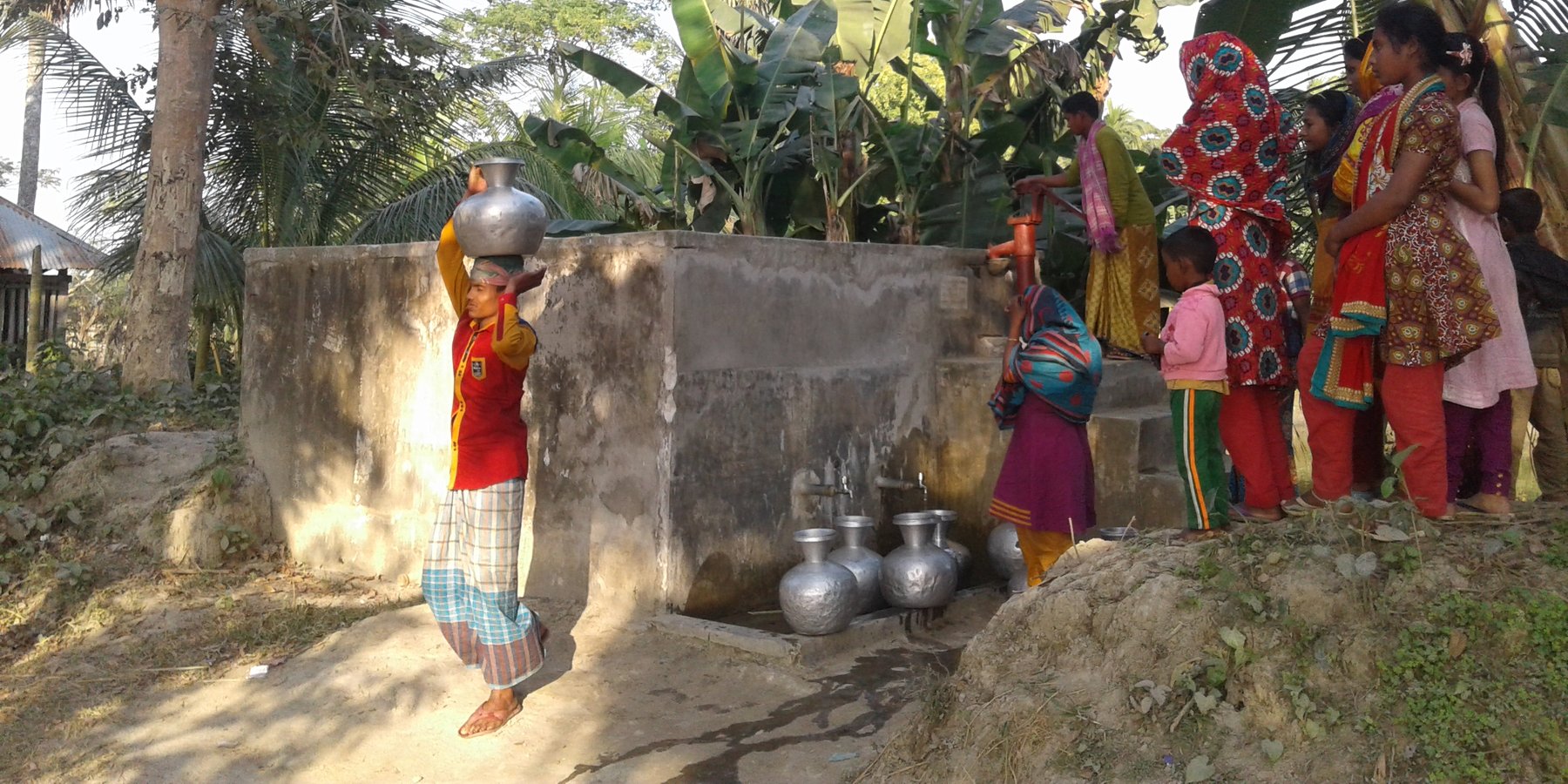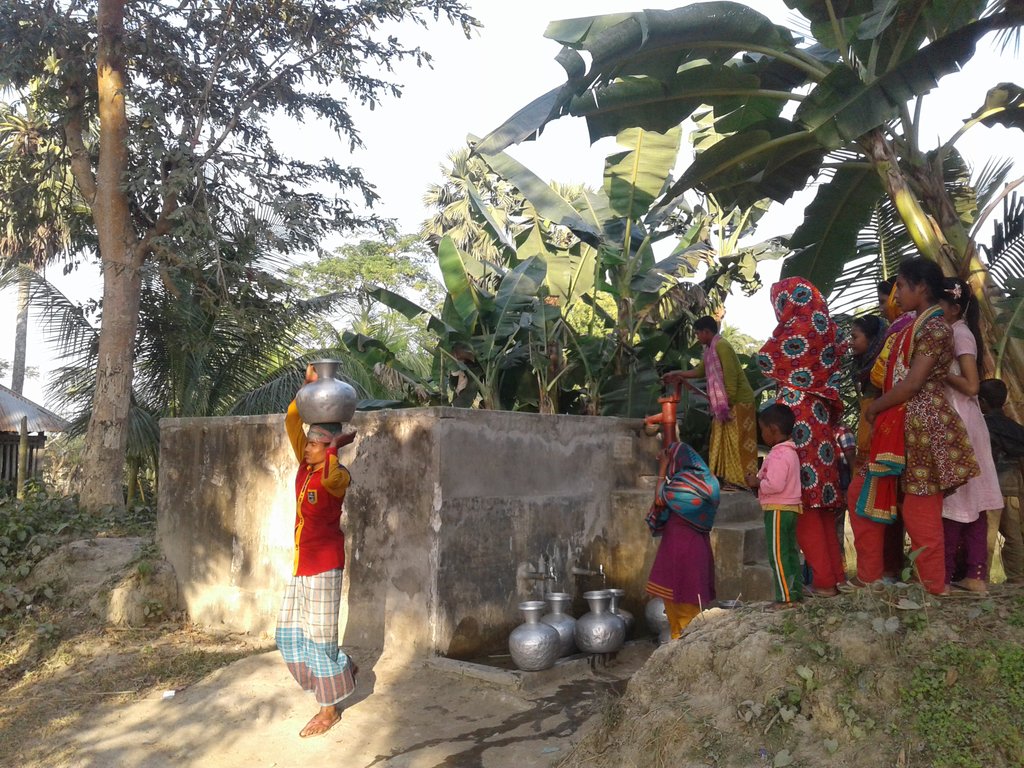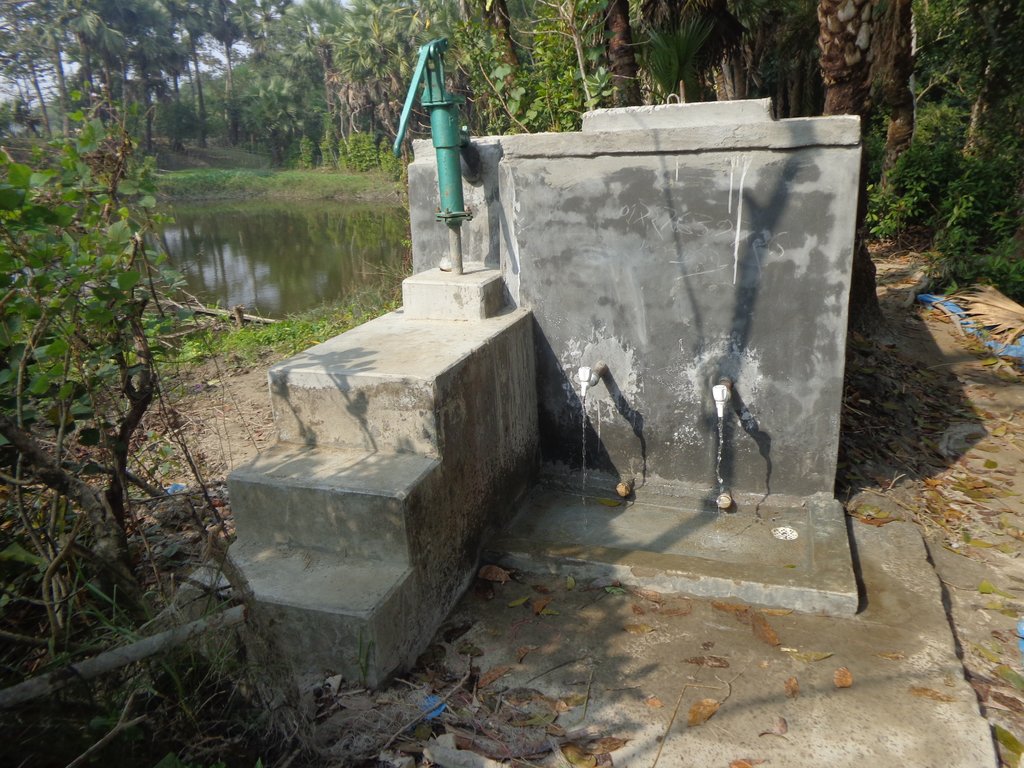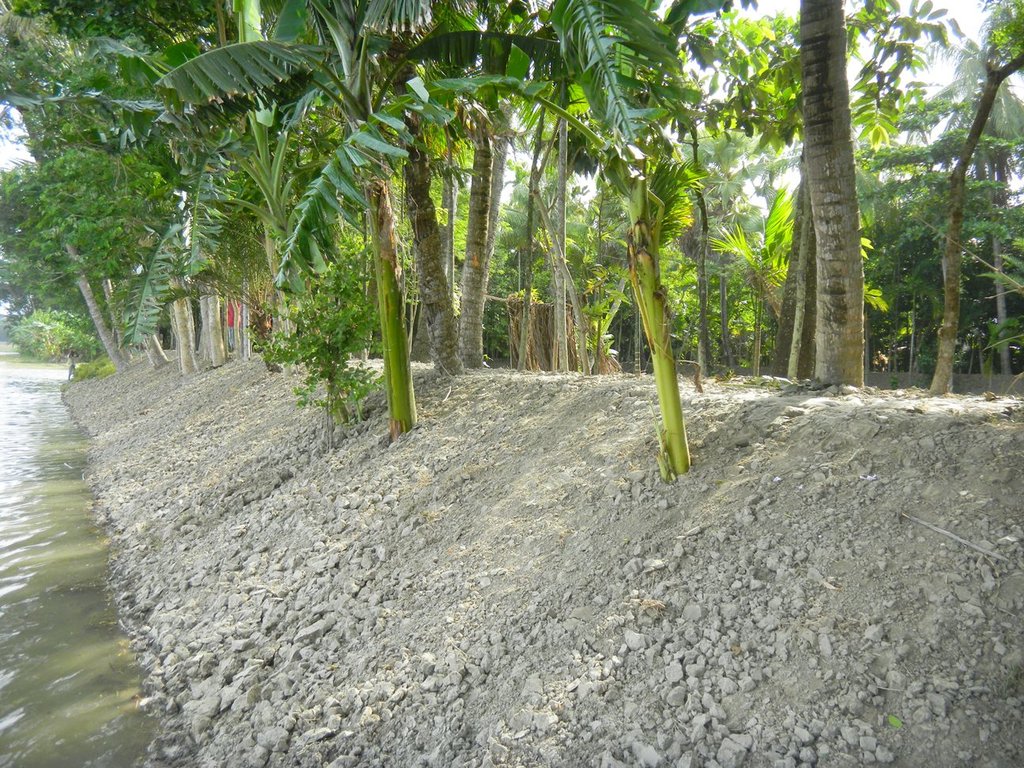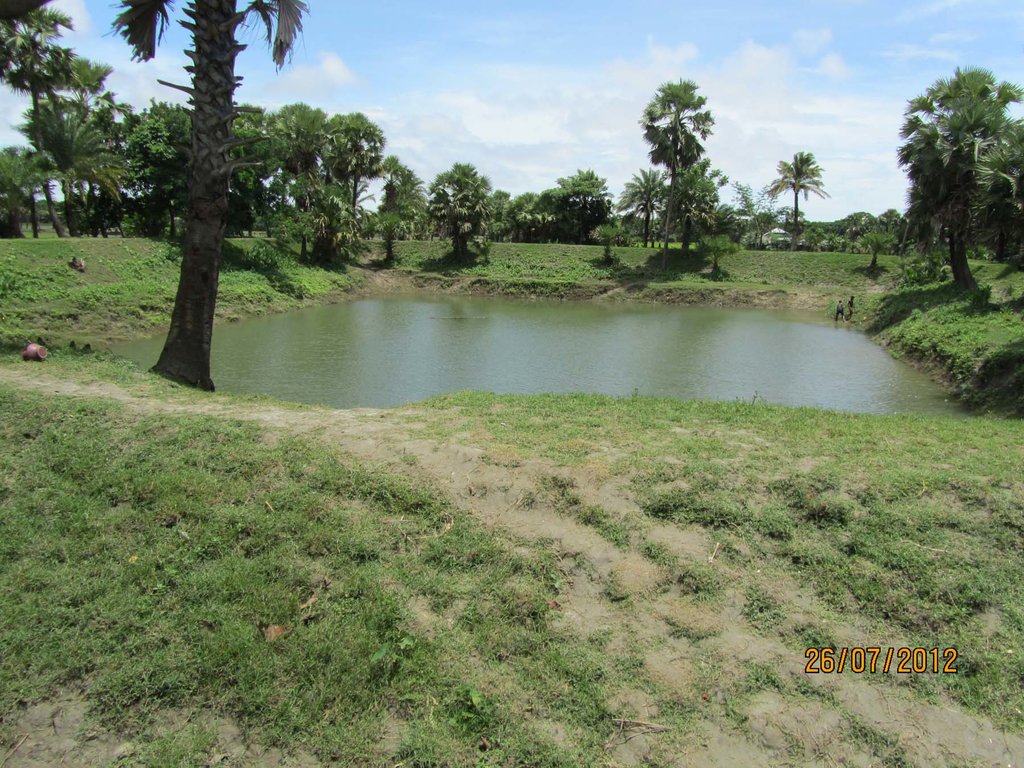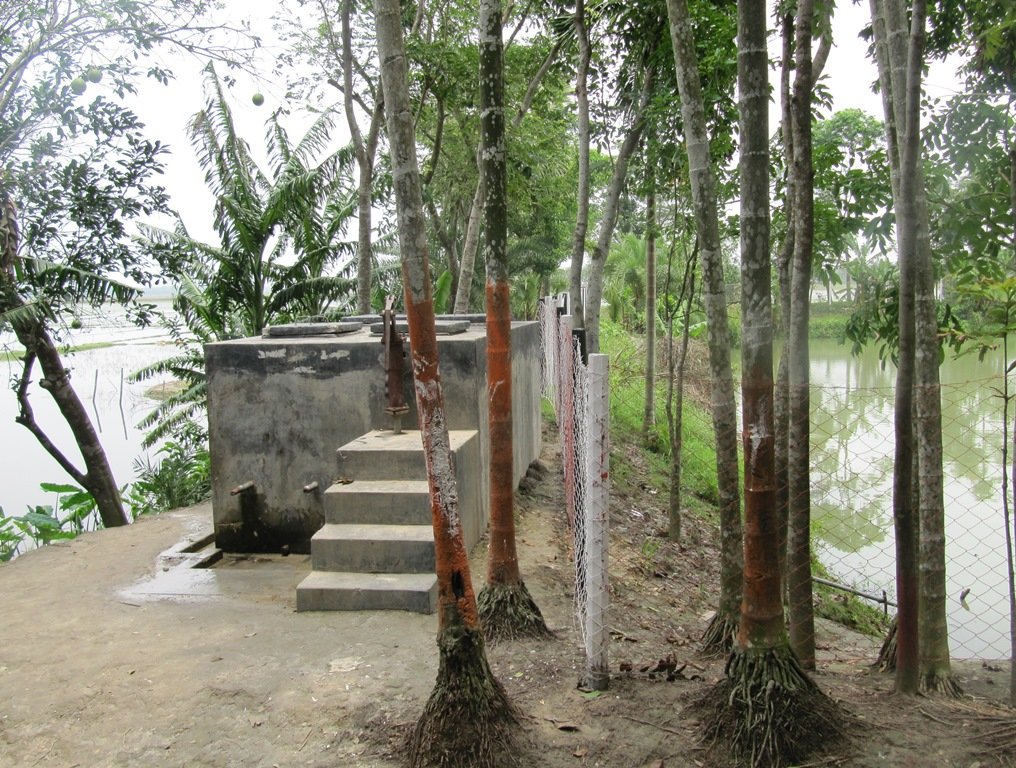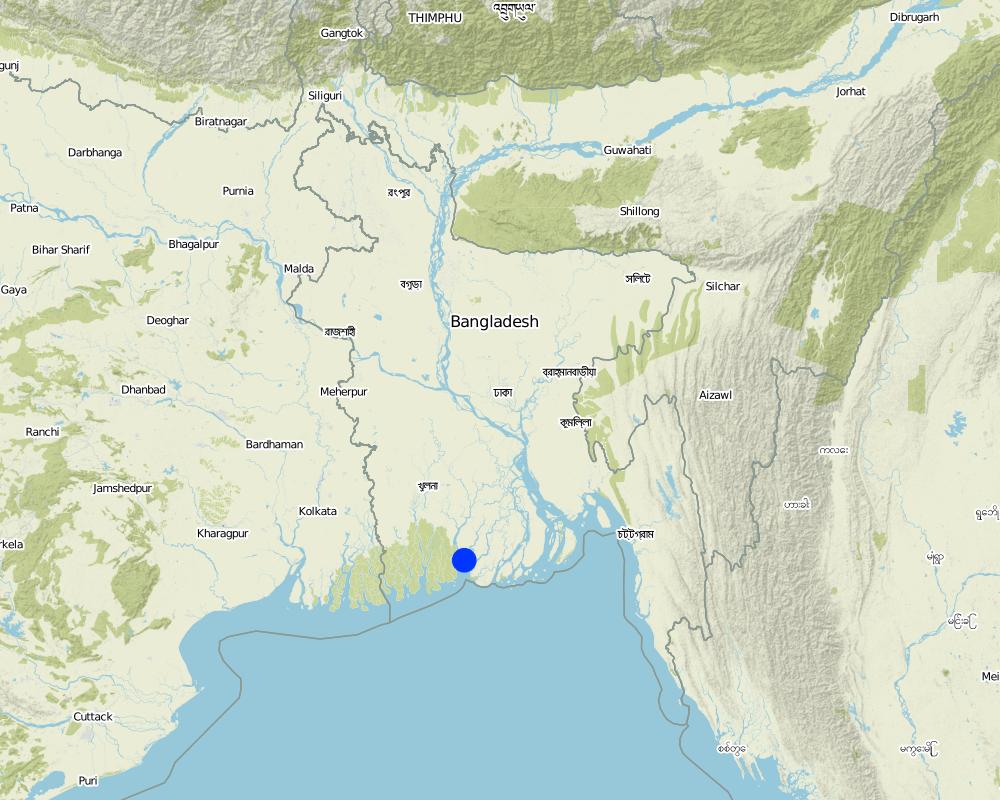Pond Sand Filter (PSF) with Raised Embankment [Бангладеш]
- Шинийг нээх:
- Шинэчлэх:
- Эмхэтгэгч: John Brogan
- Хянан тохиолдуулагчид: Shahid Kamal, Md. Rahmatullah Faruque
- Хянагчид: Alexandra Gavilano, Hanspeter Liniger, Nicole Harari, Deborah Niggli
FILTER
technologies_550 - Бангладеш
Бүлгүүдийг үзэх
Бүгдийг дэлгэх Бүгдийг хаах1. Ерөнхий мэдээлэл
1.2 Технологийг үнэлэх, баримтжуулах ажилд хамаарах мэдээлэл өгсөн хүмүүс, байгууллагуудын холбоо барих мэдээлэл
Технологи баримтжуулах/үнэлэх ажилд дэмжлэг үзүүлсэн төслийн нэр (шаардлагатай бол)
Book project: where people and their land are safer - A Compendium of Good Practices in Disaster Risk Reduction (DRR) (where people and their land are safer)Технологи баримтжуулах/үнэлэх ажилд дэмжлэг үзүүлсэн байгууллага(ууд)-ын нэр (шаардлагатай бол)
Terre des Hommes (Terre des Hommes) - Швейцар1.3 ВОКАТ-аар баримтжуулсан өгөгдлийг ашиглахтай холбоотой нөхцөл
Мэдээллийг хэзээ (газар дээр нь) цуглуулсан бэ?
16/08/2016
Эмхэтгэгч болон гол мэдээлэгч хүн(хүмүүс) WOCAT аргачлалаар баримтжуулсан мэдээллийг ашиглахтай холбоотой нөхцлийг хүлээн зөвшөөрсөн:
Тийм
1.4 Технологи тогтвортой гэдгийг баталгаажуулах
Энэ технологийг газрын доройтлыг бууруулж, газрын тогтвортой менежментийг хангахад тохиромжтой гэж үзэж болох уу?
Үгүй
2. ГТМ Технологийн тодорхойлолт
2.1 Технологийн товч тодорхойлолт
Технологийн тодорхойлолт:
The combination of pond sand filters (PSF) and raised pond embankments protect drinking water sources and increase the resilience to flood and tidal surge events in low-lying coastal areas.
2.2 Технологийн дэлгэрэнгүй тодорхойлолт
Тодорхойлолт:
Coastal areas along the Bay of Bengal experience extreme seasonal variance in the presence of surface water including flooding, tidal surge, and drought. Many families living in these rural communities construct small ponds to ensure water availability for a variety of uses, such as washing, bathing, fish farming and animal watering as well as domestic use. Some families build larger ponds that are open to the use of all community members; whereby water is carried by women and children to households. Use of pond surface water may last up to several months during the year depending on the location, seasonal weather patterns, geologic conditions, capacity of the pond and user habits. Residents rely on ponds as a source of drinking water during the dry season when household rainwater harvesting techniques are no longer viable, making treatment essential.
Pond sand filters (PSF) is acentralised or semi-centralised water treatment technology often employed in many coastal areas where surface water is the only option due to saline aquifers and lack of resources for more robust, safely managed community water supply systems. The technology uses slow-sand filtration to remove turbidity (sediments) and pathogenic organisms whereby freshwater flows through layers of sand and gravel populated by a thin layer of microorganisms and treatment happens through physical and biological processes. Due to resource constraints, the number of PSF serving as water sources is usually limited. The technology considerably reduces the risk of infection with enteric pathogens. In conjunction with PSF, safe water transport (covered and cleaned containers) and household water treatment systems (chemical or additional filtration devices) are essential.
As stated in the Sustainable Sanitation and Water Management Toolbox (SSWM) slow sand filtration systems are characterised by a high reliability and rather low lifecycle costs. Moreover, neither construction nor operation and maintenance require more than basic skills. Hence, slow sand filtration is a promising filtration method for small to medium-sized, rural communities with a fairly good quality of the initial surface water source. As stated by the the World Health Organisation, slow sand filtration provides a simple but highly effective and considerably cheap tool that can contribute to a sustainable water management system.
Once a SSF facility is built, only clean sand is required for occasional replacement. The sand layers are put in gradually according to their grain sizes: rather coarse grains at the bottom and fine grains at the top. The sand-bed is usually covered with one meter of supernatant water (LOGSDON 2003). As the process of biological filtration requires a fair amount of time in order to improve effectiveness of water treatment, SSFs usually operate at slow flow rates between 0.1 – 0.3 m3/h per square metre of surface (WHO n.y.). The water thus remains in the space above the medium for several hours and larger particles are allowed to separate and settle. It then passes through the sand-bed where it goes through a number of purification processes (HUISMAN 1974).
Due to the risk of inland flooding and (seawater) tidal surges from offshore storms, communities build earthen embankments around the ponds to prevent contamination. Local authorities and community members must be involved in the design height of the embankment—which should be equivalent to the highest pre-recorded flood level. In the geo-referenced area (Patharghata) this is equivalent to the tidal surge of Cyclone Sidr (2007). Constructed roadways are often a good reference point. In southern Bangladesh , rural roadways are built to at a ten-year flood return period, so exceeding this height according to the means of the community and/or project is recommended.
Pond embankments are best raised with soil preferably of a clayey nature. The final covering layer must be rich in clay. Embankments should be planted with native grasses and flora that have strong root systems to stabilize slopes and prevent erosion during the rainy season and in cases of tidal surge due to storms. In Bangladesh, the native kolmi (Ipomoea) has proven effective. Community members have also planted crops on the embankments, such as banana trees, medicinal plants and even small garden trenches in the middle of the slope. Beyond structural support, the horticulture helps diversify nutrition and can provide a source of income for maintaining the pond sand filter.
Fences should be installed to prevent animals from entering ponds reserved for drinking water. Community members must guarantee that the ponds selected for PSF construction shall not be used for purposes such as: washing, bathing, fish farming (natural fish however can be allowed), direct cattle access washing and watering. Furthermore:
• Fertilizers and other chemicals shall never be allowed to go into the pond.
• The flow of any polluting materials in the vicinity of the pond shall always be directed away from the pond.
• Latrines, cowsheds, garbage dumps, graveyards, fuel outlets and similar polluting structures shall not be constructed within a distance of 30 meters from the pond.
• Duck or poultry rearing hanging sheds shall never be constructed over the pond.
2.3 Технологийн гэрэл зураг
2.5 Энэ үнэлгээнд хамрагдсан технологийг хэрэгжүүлсэн улс орон/ бүс нутаг/ байршил
Улс:
Бангладеш
Улс/аймаг/сум:
Patharghata, Barguna district in coastal region
Байршлын дэлгэрэнгүй тодорхойлолт:
Baratangra, Ward:4, Union: Patharghata Union Parishad
Map
×2.6 Хэрэгжсэн хугацаа
Байгуулсан тодорхой оныг мэдэхгүй бол баримжаа хугацааг тодорхойл:
- <10 жилийн өмнө (саяхны)
2.7 Технологийн танилцуулга
Технологийг хэрхэн нэвтрүүлснийг тодорхойл:
- Уламжлалт системийн хэсэг (> 50 жил)
- Гадны төсөл/хөтөлбөрийн дэмжлэгтэйгээр
3. ГТМ технологийн ангилал
3.1 Технологийн үндсэн зорилго (ууд)
- гамшгийн эрсдлийг бууруулах
- уур амьсгалын өөрчлөлт/ экстрим байдал болон түүний нөлөөлөлд дасан зохицох
3.2 Технологи нэвтрүүлсэн газрын одоогийн газар ашиглалтын хэлбэр(үүд)

Тариалангийн талбай
- Нэг наст үр тариа
- Олон наст (модлог биш) үр тариа
- Мод, сөөг тарих

Холимог (тариалан/бэлчээр/мод), үүнд. ХАА-н ойжуулалт
- ХАА-н ойжуулалт
3.3 Газар ашиглалтын тухай нэмэлт мэдээлэл
Технологи хэрэгжүүлсэн газрын усан хангамж:
- Байгалийн усалгаатай
Жилд ургамал ургах улирлын тоо:
- 2
3.4 Технологи ГТМ-ийн аль бүлэгт хамаарах вэ
- гадаргын усны менежмент (булаг, гол, нуур, тэнгис гэх мэт)
3.5 Технологийн хамрах талбай
Технологи өргөн дэлгэрсэн эсхийг тодорхойл:
- тодорхой газар хэрэгжсэн/ жижиг талбайд төвлөрсөн
Тайлбар:
This technology may be applied to selected ponds within a community.
3.6 Технологийг бүрдүүлэх ГТМ арга хэмжээ

Барилга байгууламжийн арга хэмжээ
- S2: Далан, хаалт
- S5: Далан, усан сан, цөөрөм
- S7: Ус хуримтлуулах/ усаар хангах/ усалгааны төхөөрөмж
3.7 Технологид харгалзах газрын доройтлын төрөл

хөрс усаар эвдрэх
- Wt: Хөрсний гадаргын угаагдал

усны доройтол
- Hs: Гадаргын усны хэмжээ багасах
- Hp: Гадаргын усны чанар муудах
Тайлбар:
Preventing salt water intrusion, the surface water quality and quantity is protected. Turfing and planting the embankment prevents erosion.
3.8 Газрын доройтлоос урьдчилан сэргийлэх, сааруулах ба нөхөн сэргээх
Газрын доройтолтой холбоотойгоор Технологи ямар зорилго тавьсан болохыг тодорхойл:
- холбогдолгүй
4. Техникийн нөхцөл, хэрэгжүүлсэн үйл ажиллагаа, материал ба зардал
4.1 Технологийн техник зураг
4.2 Техникийн үзүүлэлт/ техникийн зургийн тайлбар
PSF is built on top of the raised embankment as a reinforced concretes structure consisting of a sand filter chamber, filtered water chamber and the sedimentation tank. The height is 4 feet 2 inches; Length-14 feet 5 inches; Width-7 feet. The capacity of PSF is 2500 liters. The construction materials used include include brick, sand, brick chips, cement, galvanized iron pipe, water tap and rebar.
The medium in the filter chamber shall comprise of three layers: 1) filter sand of 2 feet (60 cm) depth placed above 2) a 3” layer of fine gravel and 3) a 3" layer of coarse gravel.
1) The filter sand shall have the following size and grade: (a) Sand grains in the range 0.1 to 1 mm, with (b) effective size ( d10) in the range 0.15 to 0.20; and (c) Uniformity Coefficient ( d60/d10) in the range 1.5 to 2.5. Sieves are used to test sand size and grade.
The "under drainage" bottom gravel layers:
2) Fine gravel: 3” layer ¼” to 1 mm grains (gravel that passes through the ¼” sieve and are retained on 1 mm sieve)
3) Coarse gravel: 3" layer of ½” to ¼” grains (gravel that passes through ½” sieve and are retained on ¼” sieve)
Use different sized sieves made of wire mesh in wooden frame to prepare the media to prepare the two layers of gravel.
Every 5-6 weeks (or when flow rate is limited) cleaning the filter should be performed. Remove the filter aggregate layers, clean the PSF by removing any remaining objects in the three chambers (sand filter chamber, filtered water chamber and the sedimentation tank). Clean these chambers thoroughly using hard brush in necessary. Sequentially clean and replace t the coarse gravel media, then the fine gravel media, and finally the filter sand. For cleaning the gravel and sand place about 1/4th bucket of grave or the sand in plastic bucket (8, 10 or 12 liters, whichever may be convenient), pour about ½ bucket of water and then wash lifting the gravel or the sand from the bottom with hand several times, then decant the water by tilting the bucket. (Only fine particles less than 0.1 mm should be poured out while washing the sand.)
Raised Pond embankments are built with earthworks of clayey soils designed per the maximum flood height. The design depicted in this section is an indication, however the services of a qualified structural/civil engineer will be required. In general building the embankment is raised 0.6m above the maximum flood level is recommended, at a slope of 1:2. From the ground level, the average height of an embankment is two meters, and the average excavation depth is also two meters. All plans for both embankment works and PSF construction were reviewed and approved by the Bangladesh Government Department of Public Health and Engineering.
4.3 Материал болон зардалд хамаарах ерөнхий мэдээлэл
Үнэ өртөг, оруулсан хувь нэмрийг хэрхэн тооцсоныг тодорхойл:
- Технологийн нэгж тус бүр
Нэгжийг тодорхойл:
Pond Sand Filter with raised earthen embankment
Эзэлхүүн, урт зэргийг тодорхойл (тохиромжтой бол):
2,500 Litres capacity of filter; embankment average of 100 meter perimeter.
Үнэ өртөгийг тооцоход ашигласан мөнгөн нэгж:
- Америк доллар
Хөлсний ажилчны нэг өдрийн цалингийн хэмжээг тодорхойлно уу:
5 $ per day for labor
4.4 Бий болгох үйл ажиллагаа
| Үйл ажиллагаа | Арга хэмжээний төрөл | Хугацаа | |
|---|---|---|---|
| 1. | Community consultation for Committee Formation | Менежментийн | Before onset of rain |
| 2. | Create PSF Users' Committee, agre on user contributions | Менежментийн | Before onset of rain |
| 3. | Committee / pond selection approved by local Government | Менежментийн | Before onset of rain |
| 4. | Technical orientation to PSF Committee, input on designs | Менежментийн | Before onset of rain |
| 5. | Excavation of Pond | Барилга байгууламжийн | Before onset of rain |
| 6. | Embankment Construction | Менежментийн | Before onset of rain |
| 7. | PSF Construction | Барилга байгууламжийн | |
| 8. | Fencing | Барилга байгууламжийн | |
| 9. | Turfing and hortiuclutre on the embankment | Агрономийн | Before onset of rain |
| 10. | PSF Training on Media Selection and maintenance | Менежментийн | Regular intervals throughout the year (every 1-2 months) |
| 11. | Pond embankment maintenance | Барилга байгууламжийн | Before onset of rain |
Тайлбар:
In general, the community approach begins with several consultation meetings in the community (inclusive: gender balanced and representative of the diversity makeup of the community) and with municipal authorities. An Outcome Mapping process is initiated to observe signs that a village is prepared and mobilized to receive support for PSF and pond embankment construction. Families must be willing to participate and contribute in the construction and take complete responsibility for operation and routine maintenance.
During the initial phase, a PSF Users’ Committee is formed and approved by the municipal government. Its members make time to participate in trainings on the design, use, maintenance and community organization for managing a PSF. Importantly, the PSF User’s committee must seek public commitments toward the construction costs in cash and/or in kind (labor, construction materials, embankments plants, etc). In Bangladesh this was 10% and usually in kind. Roles and responsibilities of the PSF Users’ Committee:
1) Be responsible for regular operation, maintenance and cleanliness of the pond sand filter;
2) Ensure that the maintenance points for pond water quality is respected per the manual;
3) Advocate for local authorities to conduct regular water quality testing; and to promote household water treatment systems
4) Establish a system of collecting money from users for the regular maintenance;
5) Organize Committee meetings before the start of each season and whenever needed. Similarly if required organize a wider meeting with users in connection with resolving any O&M issues.
6) Care for the tools and other materials that may be purchased for the pond sand filter.
Selection of ponds for PSF construction should be participative with criteria agreed and communicated with the community members and local authorities. The following criteria are suggested based on Terre des hommes’ experience in Bangladesh:
• Ponds that are large enough to retain water throughout the dry season.
• The salinity of the pond water must not exceed 600 ppm at any time of the year.
• While the location of the PSF should be close to a family to ensure its security, it must be as centrally located as possible for ease of access
• Freely accessible to the public; ideally donated for public use.
• Ponds located on higher ground and thus more resistant to flooding / sea water intrusion.
• Space available for raising the embankments around the ponds
• Ponds most accessible to a largest segment of the population during disaster.
• Each PSF should have an effective drainage space and system.
4.5 Бий болгоход шаардагдсан зардал, хөрөнгийн өртөг
| Зардлын нэр, төрөл | Хэмжих нэгж | Тоо хэмжээ | Нэгжийн үнэ | Зардал бүрийн нийт өртөг | Нийт дүнгээс газар ашиглагчийн төлсөн % | |
|---|---|---|---|---|---|---|
| Хөдөлмөр эрхлэлт | Pond Excavation and Embankment Raising | Person-days | 180.0 | 5.0 | 900.0 | 10.0 |
| Хөдөлмөр эрхлэлт | Pond Fencing Works | Person-days | 20.0 | 5.0 | 100.0 | |
| Хөдөлмөр эрхлэлт | Masonry | Person-days | 36.0 | 6.25 | 225.0 | |
| Тоног төхөөрөмж | Repairing tools | Set | 1.0 | 15.0 | 15.0 | |
| Тоног төхөөрөмж | Tubewell/handpump | Pieces | 1.0 | 35.0 | 35.0 | 10.0 |
| Тоног төхөөрөмж | Sanitary Fittings | Set | 1.0 | 100.0 | 100.0 | |
| Бордоо ба биоцид | Bleaching powder for disinfection | kg | 2.0 | 1.0 | 2.0 | 10.0 |
| Бордоо ба биоцид | Lime for cleaning | kg | 50.0 | 0.5 | 25.0 | |
| Барилгын материал | ||||||
| Барилгын материал | ||||||
| Барилгын материал | bricks | pieces | 6000.0 | 0.075 | 450.0 | 10.0 |
| Барилгын материал | cement | 50 Kilo Bags | 50.0 | 5.75 | 287.5 | 10.0 |
| Барилгын материал | sand | cubic feet | 52.0 | 0.375 | 19.5 | |
| Барилгын материал | mild steel round bar | kg | 210.0 | 0.75 | 157.5 | |
| Бусад | Materials Transport Cost | Lump Sum | 1.0 | 185.0 | 185.0 | 10.0 |
| Технологи бий болгох нийт үнэ өртөг | 2501.5 | |||||
Хэрэв газар ашиглагч нийт зардлын 100% -иас бага хэсгийг төлсөн бол хэн голлох зардлыг гаргасан бэ:
The project requested 10% contribution in kind (materials, transport, labor) from each community. The remaining costs were covered by the project.
Тайлбар:
The budget is for raising a 100m perimeter length of embankment.
4.6 Арчилгаа/ урсгал үйл ажиллагаа
| Үйл ажиллагаа | Арга хэмжээний төрөл | Хугацаа/ давтамж | |
|---|---|---|---|
| 1. | Repairing | Бусад арга хэмжээ | Before onset of rains |
| 2. | Cleaning | Менежментийн | Before onset of rains |
4.7 Арчилгаа/урсгал ажилд шаардагдсан зардал, хөрөнгийн өртөг (нэг жилд)
| Зардлын нэр, төрөл | Хэмжих нэгж | Тоо хэмжээ | Нэгжийн үнэ | Зардал бүрийн нийт өртөг | Нийт дүнгээс газар ашиглагчийн төлсөн % | |
|---|---|---|---|---|---|---|
| Хөдөлмөр эрхлэлт | two-monthly cleaning of filter materials | Person days | 12.0 | 5.0 | 60.0 | 100.0 |
| Хөдөлмөр эрхлэлт | Seasonal erosion control | Person days | 12.0 | 5.0 | 60.0 | 100.0 |
| Бордоо ба биоцид | bleeching powder | bag | 5.0 | 2.0 | 10.0 | 100.0 |
| Технологийн арчилгаа/урсгал үйл ажиллагаанд шаардагдах нийт үнэ өртөг | 130.0 | |||||
4.8 Зардалд нөлөөлж байгаа хамгийн чухал хүчин зүйл
Өртөг, зардалд нөлөөлөх гол хүчин зүйл:
Comparatively, construction materials costs was reflected as the most expensive consideration.
5. Байгаль ба нийгмийн нөхцөл
5.1 Уур амьсгал
Жилийн нийлбэр хур тундас
- < 250 мм
- 251-500 мм
- 501-750 мм
- 751-1,000 мм
- 1,001-1,500 мм
- 1,501-2,000 мм
- 2,001-3,000 мм
- 3,001-4,000 мм
- > 4,000 мм
Холбогдох цаг уурын станцын нэр:
www.discoverybangladesh.com
Агро-уур амьсгалын бүс
- хагас хуурай
5.2 Гадаргын хэлбэр
Дундаж налуу:
- хавтгай (0-2 %)
- бага зэрэг налуу (3-5 %)
- дунд зэрэг налуу (6-10 % )
- хэвгий (11-15 %)
- налуу (16-30 %)
- их налуу (31-60 % )
- эгц налуу (>60 %)
Гадаргын хэлбэр:
- тэгш өндөрлөг / тал
- нуруу
- уулын энгэр
- дов толгод
- бэл
- хөндий
Өндрийн бүслүүр:
- 0-100 д.т.д. м.
- 101-500 д.т.д. м.
- 501-1,000 д.т.д м.
- 1,001-1,500 д.т.д м.
- 1,501-2,000 д.т.д м.
- 2,001-2,500 д.т.д. м.
- 2,501-3,000 д.т.д. м.
- 3,001-4,000 д.т.д м.
- > 4,000 д.т.д. м.
Технологи дараах асуудалд хандсан эсэхийг тодорхойл:
- хамааралгүй
5.3 Хөрс
Хөрсний дундаж зузаан:
- маш нимгэн (0-20 см)
- нимгэн (21-50 см)
- дунд зэрэг зузаан (51-80 см)
- зузаан (81-120 cм)
- маш зузаан (>120 cм)
Хөрсний бүтэц (өнгөн хөрс):
- нарийн /хүнд (шаварлаг)
Хөрсний бүтэц (>20 см-ээс доош):
- нарийн /хүнд (шаварлаг)
Өнгөн хөрсөнд агуулагдах ялзмаг:
- дунд (1-3 % )
5.4 Усны хүртээмж ба чанар
Гүний усны түвшин:
5-50 м
Гадаргын усны хүртээмж:
хангалтгүй/ байхгүй
Усны чанар (цэвэршүүлээгүй):
муу чанарын ундны ус (цэвэршүүлэх шаардлагатай)
Усны давсжилтын асуудал бий юу?
Тийм
Тодорхойлно уу:
groundwater table is salty along the Bay of Bengal, salt water intrusion. Tidal surge following cyclones also creates soil salinity.
Энэ газар үерт автдаг уу?
Тийм
Тогтмол байдал:
байнга
5.5 Биологийн олон янз байдал
Зүйлийн олон янз байдал:
- дунд зэрэг
Амьдрах орчны олон янз байдал:
- дунд зэрэг
5.6 Технологи нэвтрүүлсэн газар ашиглагчдын тухай мэдээлэл
Суурьшмал эсвэл нүүдлийн:
- Суурьшмал
Үйлдвэрлэлийн системийн зах зээлийн чиг баримжаа:
- холимог (амь зуух/ худалдаа наймаа
Бусад эх үүсвэрээс олох орлого:
- Нийт орлогын 10-50 %
Чинээлэг байдлын түвшин:
- ядуу
Хувь хүн эсвэл бүлэг:
- Хувь хүн / өрх
- бүлэг / олон нийтийн
Механикжилтын түвшин:
- гар ажил
- ердийн хөсөг
Хүйс:
- эмэгтэй
- эрэгтэй
Газар ашиглагчийн нас:
- залуус
- дунд нас
5.7 Технологи нэвтрүүлсэн газар ашиглагчийн өмчилж буй, эзэмшиж буй, түрээсэлж буй эсвэл ашиглаж буй (ашиглах эрх) газрын талбай
- < 0.5 га
- 0.5-1 га
- 1-2 га
- 2-5 га
- 5-15 га
- 15-50 га
- 50-100 га
- 100-500 га
- 500-1,000 га
- 1,000-10,000 га
- > 10,000 га
Энэ талбай том, жижиг, дунд алинд хамаарах вэ (орон нутгийн нөхцөлд харгалзуулна уу)?
- бага-хэмжээний
5.8 Газар эзэмшил, газар ашиглах эрх, ус ашиглах эрх
Газар өмчлөл:
- хувь хүн, өмчийн гэрчилгээгүй
- хувь хүн, өмчийн гэрчилгээтэй
Газар ашиглах эрх:
- хувь хүн
Ус ашиглах эрх:
- нээлттэй хүртэх (зохион байгуулалтгүй)
5.9 Дэд бүтэц, үйлчилгээний хүртээмж
эрүүл мэнд:
- ядуу
- дунд зэргийн
- сайн
боловсрол:
- ядуу
- дунд зэргийн
- сайн
техник зөвлөгөө:
- ядуу
- дунд зэргийн
- сайн
хөдөлмөр эрхлэлт (жишээ нь, ХАА-аас өөр):
- ядуу
- дунд зэргийн
- сайн
зах зээл:
- ядуу
- дунд зэргийн
- сайн
эрчим хүчний хангамж:
- ядуу
- дунд зэргийн
- сайн
зам тээвэр:
- ядуу
- дунд зэргийн
- сайн
усан хангамж ба ариутгал:
- ядуу
- дунд зэргийн
- сайн
санхүүгийн үйлчилгээ:
- ядуу
- дунд зэргийн
- сайн
6. Үр нөлөө ба дүгнэлт
6.1 Технологийн талбайд үзүүлсэн нөлөө
Нийгэм-эдийн засгийн үр нөлөө
Үйлдвэрлэл
газар тариалангийн үйлдвэрлэл
Тайлбар/ тодорхой дурьдах:
Embankments provide a modest space for small scale gardening and fruit/medicinal tree cultivation. Such agriculture activities would be protected from tidal surge waters that destroy agriculture in low-lying areas.
Усны хүртээмж ба чанар
ундны усны хүрэлцээ
Тайлбар/ тодорхой дурьдах:
Terre des hommes had raised embankments on ten community ponds prior to cyclone Mahasen (2013). Nine of the ten ponds embankments remained intact, preserving valuable fresh water from sea water contamination for drinking after treatment with PSF.
ундны усны чанар
ГТМ хэрэгжихээс өмнөх тоо хэмжээ:
>1000 fecal coliform units
ГТМ хэрэгжиснээс хойшхи тоо хэмжээ:
<10 fecal coliform units
Тайлбар/ тодорхой дурьдах:
The PSF water source considerably reduces the risk of infection with enteric pathogens from the pond water. In Terre des hommes’ field experience, although a reduction in presence of fecal coliform (FC) by over 99% is possible, the PSF technology rarely eliminates all FC. A level of 1-10 fecal coliform units (FCU: colonies of E. coli per 100 mL of water) has been achieved, which is equivalent to an intermediate risk, or “probably safe” as defined by WHO. In conjunction with PSF, safe water transport (covered and cleaned containers) and household water treatment systems (chemical or additional filtration devices) are essential.
Орлого, зарлага
эдийн засгийн ялгаат байдал
Нийгэм-соёлын үр нөлөө
эрүүл мэндийн байдал
Тайлбар/ тодорхой дурьдах:
Users reported a decrease in water borne diseases through use of PSF water compared to surface water.
6.2 Технологийн талбайн гадна үзүүлсэн үр нөлөө
Усны хүртээмж
Тайлбар/ тодорхой дурьдах:
During disaster, the use of the PSF increased, with people walking from further distances to take water from the PSF to their homes.
6.3 Технологийн уур амьсгалын өөрчлөлт, цаг агаарын гамшигт үзэгдэлд өртөх байдал ба эмзэг байдал (газар ашиглагчийн бодлоор)
Уур амьсгалаас хамаарах аюул (гамшиг)
Уур амьсгалын гамшиг
| Технологи түүний нөлөөг хэрхэн бууруулж байна? | |
|---|---|
| ган гачиг | сайн |
Усзүйн гамшиг
| Технологи түүний нөлөөг хэрхэн бууруулж байна? | |
|---|---|
| далайн үер / задгай усны үер | маш сайн |
Тайлбар:
PSF serves as disaster resilient Technology that helps residents in coastal villages along the Bay of Bengal to cope with the effects of climate change; such as increased incidence and intensity of storms and salt water intrusion.
6.4 Өртөг ба ашгийн шинжилгээ
Бий болгох зардалтай харьцуулахад ямар ашиг өгсөн бэ (газар ашиглагчийн бодлоор)?
Богино хугацаанд эргэн төлөгдөх байдал:
бага зэрэг эерэг
Урт хугацаанд эргэн төлөгдөх байдал:
эерэг
Арчилгаа/урсгал зардалтай харьцуулахад ямар ашиг өгсөн бэ (газар ашиглагчийн бодлоор)?
Богино хугацаанд эргэн төлөгдөх байдал:
нөлөө үл мэдэг
Урт хугацаанд эргэн төлөгдөх байдал:
эерэг
6.5 Технологи нэвтрүүлэлт
- 50 -иас их %
Технологи нэвтрүүлсэн хүмүүсээс хэд нь өөрийн хүчээр технологийг хэрэгжүүлсэн бэ, өөрөөр хэлбэл гадны тусламж дэмжлэг авалгүйгээр?
- 0-10%
6.6 Дасан зохицох
Бий болсон өөрчлөлтөд зохицуулан технологийг өөрчилсөн үү?
Үгүй
6.7 Технологийн давуу тал/боломжууд
| Газар ашиглагчдын тодорхойлсон давуу тал/боломжууд |
|---|
| The Technology is useful for supplying drinking water at household level and supports cultivation of fruit trees, medicinal plants and vegetables at the pond embankment, above the flood line. |
| Эмхэтгэгч, бусад мэдээлэл өгсөн хүмүүсийн өнцгөөс тодорхойлсон давуу тал/боломжууд |
|---|
| The Technology is conducive for ensuring supply of water for drinking, cooking and irrigation purposes if the community is motivated and understands the impact of PSF when faced with water shortage during dry season and other disaster events. |
6.8 Технологийн дутагдалтай/сул тал/аюул болон тэдгээрийг хэрхэн даван туулах арга зам
| Эмхэтгэгч, бусад мэдээлэл өгсөн хүмүүсийн өнцгөөс тодорхойлсон сул тал/ дутагдал/ эрсдэл | Тэдгээрийг хэрхэн даван туулах вэ? |
|---|---|
| Every five to six weaks, the PSF filter media needs to be maintained, requiring some training, as well organising labor and collecting petty funds for bleaching powder. | The PSF User's Manual has been translated into local language with images and tips for maintenance. This is distributed following the training. The PSF User's Committee must regularly collect user fees for smooth operations. A bank account promotes transparency. Sale of crops harvested on the embankments can help defray costs of maintenance. |
| Although not laborious, the hand pump requires some degree of force, and the taps are often a target of children's play. | Children should be supervised and small children must not be allowed to operate or play near the pump. Investing in sturdy tap systems is essential. |
|
The bio-film will form after seven days of operating the pump. |
Users must boil or treat water very carefully in this period. |
| Private owners could lose interest availing their asset for the communty. For example, they may start using the pond for fish farming in order to sustain their livelihoods. | Formal agreements with the municipality about the usage rules for the pond, and public commitments taken by the pond owners are important. Posting signboards that identify the pond as "Drinking Water Only" and specify forbidden activities is also helpful. Owners can take a higher share of crops cultivated on the embankment. |
7. Ном зүй ба холбоосууд
7.1 Мэдээлэл цуглуулсан арга/эх үүсвэр
- Хээрийн уулзалт, судалгаа
Interviews with six informants
- тайлан болон бусад эх сурвалжийн бүрдэл
Compilation from five documents from past projects.
7.2 Ном, хэвлэлийн ишлэл
Гарчиг, зохиогч, он, ISBN:
SSWM University Course Module 6: Disaster Situations: Planning and Preparedness Further Resources: Water Purification Slow Sand Filtration, Marco A. Bruni, Dorothee Spuhler (seecon international gmbh), 2012.
Хаанаас авч болох вэ? Зардал?
https://www.sswm.info/sswm-university-course/module-6-disaster-situations-planning-and-preparedness/further-resources-0/slow-sand-filtration
Гарчиг, зохиогч, он, ISBN:
Pond Sand Filter (PSF) Manual – community operation and maintenance, Laxman Kharal (Terre des hommes), 2012
Хаанаас авч болох вэ? Зардал?
Contact: info@tdh.ch
Гарчиг, зохиогч, он, ISBN:
Guidelines for Drinking Water Quality, 4th Edition, WHO, 2011
Хаанаас авч болох вэ? Зардал?
http://www.who.int/water_sanitation_health/publications/2011/dwq_guidelines/en/
Холбоос ба модулууд
Бүгдийг дэлгэх Бүгдийг хаахХолбоосууд
Холбоос байхгүй байна
Модулууд
Модуль байхгүй байна


